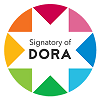Malocclusions in students of the school of Dentistry at the UTE University
DOI:
https://doi.org/10.37135/ee.04.08.04Keywords:
Malocclusion, Prevalence, OverbiteAbstract
Malocclusion is considered one of the most common problems related to oral health, its early and adequate diagnosis allows establishing a correct and more effective treatment plan. The objective was to describe the malocclusions of students of the school of dentistry in final academic term at the UTE University in Quito, Ecuador, during the years 2018 and 2019. The data were obtained from the respective medical records on file at the SERODU university clinic. The evaluations to determine the malocclusion were made from the characterization of the vertical, horizontal, and transverse planes, using the Angle criteria. The mean age among the patients was 24.5 years, with a standard deviation of 1.91. The analysis of the presence of overjet and overbite allowed establishing that the highest mean measurement was framed in molar class II, for 4.19 mm (SD = 3.07) and 3.59 mm (SD = 2.47), respectively. The unilateral crossbite on the transverse axis (26.67%). The normal category prevailed in the type of bite in the horizontal and vertical planes in the three molar classes.
Downloads
References
Lin M, Xie C, Yang H, Wu C, Ren A. Prevalence of malocclusion in Chinese schoolchildren from 1991 to 2018: A systematic review and meta-analysis. Int J Paediatr Dent. 2019; 00: 1-12.
NCBI. Malocclusion - MeSH. [Internet]. [citado 29 de noviembre de 2019]. Disponible en: https://www.ncbi.nlm.nih.gov/mesh/68008310.
Shivakumar KM, Chandu GN, Subba Reddy VV, Shafiulla MD. Prevalence of malocclusion and orthodontic treatment needs among middle and high school children of Davangere city, India by using Dental Aesthetic Index. J Indian Soc Pedod Prev Dent [Internet]. [citado 29 de noviembre de 2019]; 27(4): 211-8. Disponible en: http://www.ncbi.nlm.nih.gov/pubmed/19915271.
Chauhan D, Chauhan T, Gupta K, Sachdev V. A study of malocclusion and orthodontic treatment needs according to dental aesthetic index among school children of a hilly state of India. J Int Soc Prev Community Dent. 2013; 3(1): 32.
Grippaudo C, Paolantonio EG, Antonini G, Saulle R, La Torre G, Deli R. Associazione fra abitudini viziate, respirazione orale e malocclusione. Acta Otorhinolaryngol Ital. 1 de octubre de 2016; 36(5): 386-94.
Kapoor D. Assessment of Knowledge on Key Features of Angle’s Class II Division 1 Malocclusion among Dental School Under-graduates. Orthod J Nepal. 2018; 8(1): 37-9.
Ugalde-Morales J. Clasificación de la maloclusión en los planos anteroposterior, vertical y transversal. Rev ADM. 2007; LXIV(3): 97-109.
Souza C, Coura P, Coura L, DeOliveira S. Prevalence of Angle Class I, II and III malocclusion in a Orthodontics Specialization Course of Anápolis. Sci Investig Dent [Internet]. 2016 [citado 29 de noviembre de 2019]; 21(1): 29-33. Disponible en: http://revistas.unievangelica.com.br/index.php/scientificinvestigationindestist/article/view/2105.
Talley M, Katagiri M, Elorza H. Casuística de maloclusiones Clase I, Clase II y Clase III según Angle en el Departamento de Ortodoncia de la UNAM. Rev Odontológica Mex. 2007; 11: 175-80.
Shioya S, Arai K. Dentoskeletal morphology of adult Class II division 1 and 2 severe deep overbite malocclusions. Orthod Waves. 1 de junio de 2017; 76(2): 97-104.
Ramírez-Mendoza M, Antonio Maloclusión clase III M. Salud en Tabasco [Internet]. 2010 [citado 29 de noviembre de 2019]; 16(3): 944-50. Disponible en: www.saludtab.gob.mx/revista.
Andrews LF. The 6-elements orthodontic philosophy: Treatment goals, classification, and rules for treating. Amer J Orthod and Dentof Orthop. 2015; 148: 883-7.
Andrews LF. The six keys to normal occlusion. Am J Orthod. 1972; 62(3): 296-309.
Losoviz E. Los conceptos de Lawrence F. Andrews: ¿ciencia o dogma? RAAO [Internet]. 2018 [citado 4 de febrero de 2020]; 59(2): 33-42. Disponible en: https://www.ateneo-odontologia.org.ar/articulos/lix02/articulo5.pdf.
Plazas J, Martínez O, Castro L, Solana A, Villalba L. Prevalencia de maloclusiones en niños de una escuela en Cartagena de Indias. Cienc y Salud Virtual [Internet]. 2011 [citado 29 de noviembre de 2019]; 3(1): 2. Disponible en: http://revistas.curn.edu.co/index.php/cienciaysalud/article/view/38.
García VJ, Ustrell JM, Sentís J. Evaluation of malocclusion, functional and oral habits alteration in a school student population: Tarragona and Barcelona. Av Odontoestomatol [Internet]. 2011 [citado 4 de diciembre de 2019]; 27(2): 75-84. Disponible en: http://scielo.isciii.es/pdf/odonto/v27n2/original2.pdf.
Fonseca Y, Fernández E, Cruañas A. Mordida Abierta anterior. Revisión Bibliográfica. Rev Habanera Ciencias Médicas [Internet]. 2014 [citado 4 de diciembre de 2019]; 13(4): 509-15. Disponible en: https://www.medigraphic.com/pdfs/revhabciemed/hcm-2014/hcm144c.pdf.
López-Gallegos E, Armas A, López Ríos E, Nuñez A, Tatés-Almeida K. Prevalencia de hábitos deletereos y maloclusiones en dentición mixta en niños de la ciudad de Quito, Ecuador. Kiru. 2018; 15(3): 121-6.
Avellán-Arguello KE. Maloclusiones dentales como factor de riesgo de trastornos temporomandibulares en pacientes de UCSG 2017. Rev Científica “Especialidades Odontológicas UG”. 2017; 117(1).
Salinas-Abarca LM, Urgiles-Urgiles CD, Jiménez-Romero MN. Dental Malocclusions in Schools of 12 Years in the Parish El Sagrario-Cuenca 2016. Rev Salud Vida Sipanense. 2017; 4(2): 58-66.
Plazas-Román J, Martínez-Bermúdez O, Castro-Pacheco L, Solana-García AM, Villalba-Manotas LF. Prevalencia de maloclusiones en niños de una escuela en Cartagena de Indias. Cienc y Salud Virtual. 2011; 3(1): 2.
Reyes-Ramírez DE, Antón-Sarabia QG. Asociación de maloclusiones clase I, II y III y su tratamiento en población infantil en la ciudad de Puebla, México. Rev Tamé. 2018; 86(1): 175-9.
Hardy DK, Cubas YP, Orellana MF. Prevalence of angle class III malocclusion: A systematic review and meta-analysis. Open J Epidemiol. 2012; 02(04): 75-82.
Bárbara AS. Prevalence of Maloclusions in Schoolchildren of 12 Years Old At Machangara Cuenca, 2016. Rev OACTIVA UC Cuenca. 2018; 3(1): 7-12.
Urrego-Burbano PA, Jiménez-Arroyave LP, Londoño-Bolívar MÁ, Zapata-Tamayo M, Botero-Mariaca P. Perfil epidemiológico de la oclusión dental en escolares de Envigado, Colombia. Rev Salud Publica. 2011; 13(6): 1010-21.
Palacios-Hidalgo L, Carrillo D. Prevalencia de maloclusiones de Angle en niños de 9 a 13 años. OdontoInvestigación. 2015; 1(2): 24-31.
Yu X, Zhang H, Sun L, Pan J, Liu Y, Chen L. Prevalence of malocclusion and occlusal traits in the early mixed dentition in Shanghai, China. PeerJ. 2019; 2019(4): 1-15.



















